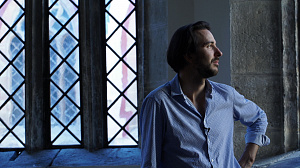
CAPPELLA MARIANA
IN THE HEART OF RENAISSANCE EUROPE


Two centuries after the prosperous era of Charles IV, Prague evidently enjoyed its second Golden Age, under the reign of the art-loving Emperor and King Rudolf II, as it became a busy cultural centre, attracting artists from all over Europe. Like in a melting pot, a variety of musical styles mingled together in the city: the Franco-Flemish polyphony, represented by the world’s most accomplished composers at the time, as well as the vigorous tradition of literary brotherhoods with the archaic polyphonic repertoire of the previous generations. The focal point of Cappella Mariana’s new album is the recently rediscovered Prague Manuscript of Polyphonic Masses, with the fabulously survived Missa Presulem ephebeatum by Heinrich Isaac, one of the most significant masters of the Franco-Flemish polyphonic style. Cappella Mariana, made up of stellar early music singers (Hana Blažíková, Barbora Kabátková, and others), have performed Renaissance polyphony to great acclaim at Europe’s most prominent concert venues and festivals. We talked about the new album with the ensemble’s artistic director, Vojtěch Semerád.
Vojtěch, what type of music does your new album feature? The title indicates that you were greatly inspired by Prague as a city.
In the 15th and 16th centuries, Prague was a very busy crossroads in the heart of Renaissance Europe. I would like to present to the listeners the rose symbolising Prague, whose flowers blossomed over the centuries, just as the city boomed from the Middle Ages to the end of the Renaissance era, thus forming an imaginary arc spanning almost two centuries. The bulk of the pieces on the album were written by composers of the Franco-Flemish school, which influenced the evolution of music throughout Europe. New pieces from the Netherlands were also in demand in Prague, and were diligently copied. I have discovered such compositions at Prague libraries. Thanks to the mobility of the musicians who gravitated towards Prague, this type of music experienced prolific development and was frequently played.
What sources did you select from and what do you deem to be the album’s pivotal work?
The axis is Heinrich Isaac’s Missa Presulem ephebeatum for four voices, which takes the listener on a musical journey through the bygone centuries. The other pieces on the album are from the Speciálník and Strahov Codices, and the Rokycany music collection. They encompass a truly extensive repertoire, from which I have only chosen sacred compositions.
Cappella Mariana is primarily a vocal ensemble, yet instrumentalists have occasionally been invited to participate in your projects. Were you not tempted to invite them to record the current album too?
Yes, I was indeed, but I wanted it to be different from our first album, Praga Magna, on which singers are accompanied by instrumentalists. Accordingly, I decided to solely make use of the ensemble’s vocal core and pick the best music that could be heard in Prague during the Renaissance era.
How challenging were the pieces to perform?
The most challenging aspect was to interconnect the stylistic facets of the music development over two centuries – from the late Medieval repertoire, which requires vocal performance different from that needed in the case of Joannes Sixtus’ music, containing elements of the ascendant Baroque style.
Will you perform the works featured on the new album at concerts?
Yes, some of them, yet I intend for us to perform the entire repertoire during the next concert seasons. I am working on minor arrangements pertaining to the sequence of the compositions.
Your ensemble has performed with various numbers of singers. What did you base the choice of the singers for the new album on?
It has always been something like a voice laboratory. Every piece required a different number of voices, from three to eight, in the case of Pierre de Bonhomme’s motet. I am really glad that all the ensemble’s main members could participate in the making of the album, including Hana Blažíková and Barbora Kabátková.
How did you select the place where the album would be recorded?
The album was recorded at the refectory of the monastery in Osek. I was seeking a place with excellent acoustics, as well as possessing a genius loci. I bore in mind a place that would draw us into a “different world”, so we could fully concentrate on our task.
What concerts are you now preparing and looking forward to?
The 2019/20 season will be based on three vital pillars. The first is a programme focusing on the music of Prague during the reign of Rudolf II, linking up to our previous album, Praga Magna, which we will present in Bremen, Germany. The second is a concert project paying tribute to Kryštof Harant, which we will bring to Oslo, Norway. The third programme will be again centred on the era of Rudolf II, and we will perform it at the festival in Potsdam.
Have you given thoughts to the next musical project you would like to record?
Yes, I have several ideas. They are related to a few anniversaries. I would like to explore Johannes Torout’s music and make it more generally known. I would also like to pay attention to the anniversary in 2021 of the Old Town Square execution of the Czech leaders, as well as the composer Kryštof Harant.